In an article published in The Times newspaper on 14 December 2019, the defence commentator Max Hastings described Britain’s two new Queen Elizabeth class carriers as “expensive, impractical and alarmingly vulnerable (which) embody everything that is wrong with our defence policy”.
This article was submitted to the UK Defence Journal by Kelvin Curnow. Kelvin’s particular area of interest is naval aircraft and aircraft carriers. He is a keen writer and over the past fifteen years he has had a number of articles published in different journals.
Such a view is at odds with the judgement of navies and defence ministries worldwide which have overseen an upswing in aircraft carrier construction in recent years. This reflects the strategic reality that only an aircraft carrier operating in concert with support vessels can provide the necessary force projection to ensure the successful prosecution of required objectives, whether that is anything from armed intervention to ‘showing the flag’.
The aircraft carrier is often the first and sometimes only means through which a government can react to a rapidly deteriorating military situation. This was no more amply illustrated than when on 8 August 2014 the first American air strikes against Islamic State (IS) terrorists in Iraq were carried out by United States Navy (USN) Boeing F/A-18 Hornet fighter aircraft launched from the USS GEORGE H.W. BUSH.
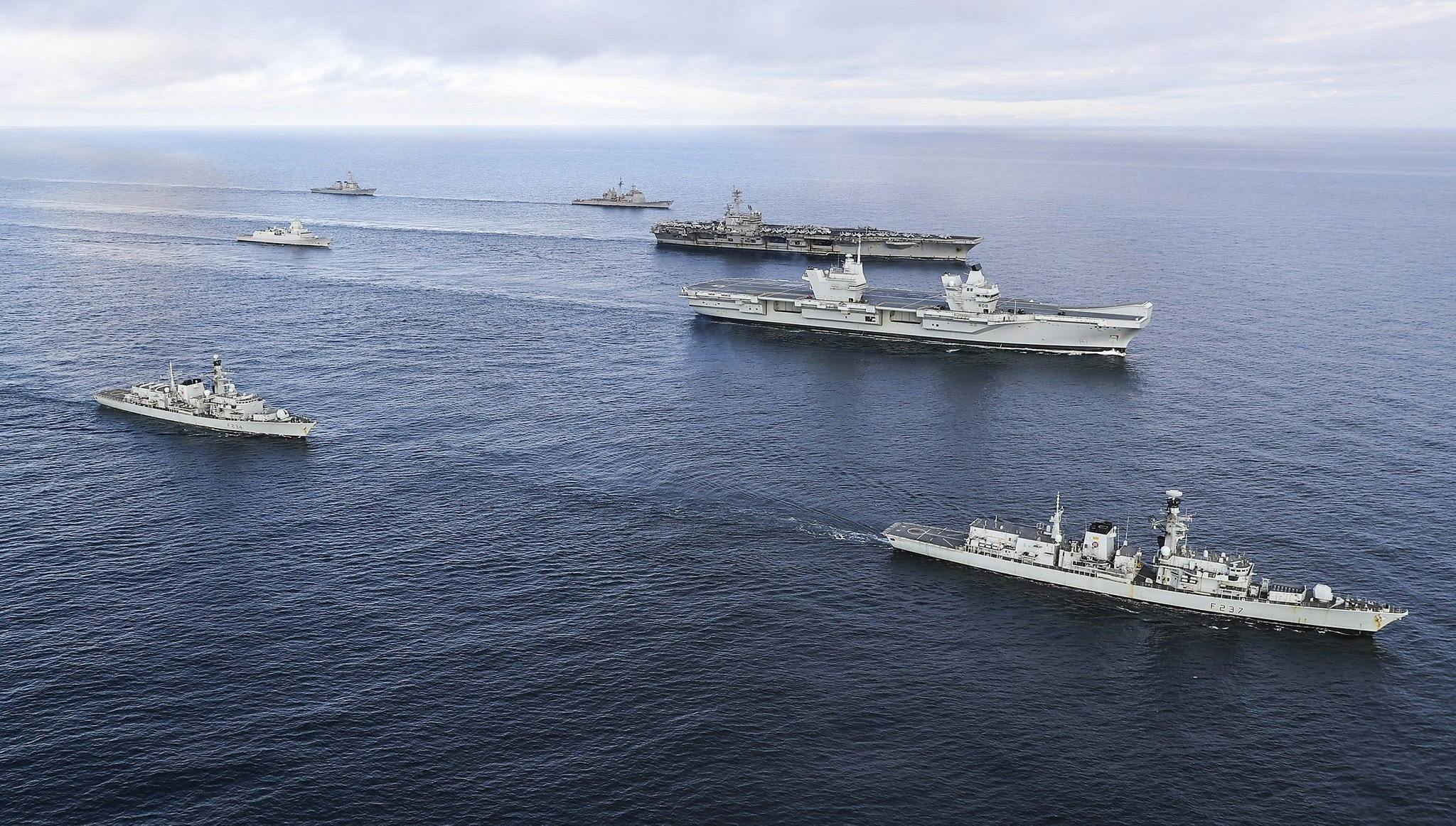
The carrier transited from the North Arabian Sea to the Persian Gulf to facilitate the strikes, initially around the Kurdish city of Erbil. The ability to sail 400+ nm in a 24 hour period to counter a rapidly evolving situation once again highlighted the flexibility of aircraft carriers in providing a swift and effective response. In some circumstances carriers are the only means by which aggression can be countered. No greater example of this this in recent modern military history can be found than in the Royal Navy’s (RN’s) successful deployment of its two carriers HMS HERMES and HMS INVINCIBLE in the Falklands war of 1982.
More and more nations are now coming to the conclusion that carrier airpower is necessary to protect their national interests, secure sea lanes and if necessary impose their will militarily.
AN EVOLUTION IN CARRIER DESIGN
At the end of the World War II there were a significant number of unfinished hulls lying in British shipyards. These were not scrapped immediately and largely because of their design they were eminently adaptable for the operation of a new generation of post war naval aircraft.
In the 1950s Colossus and Majestic class light fleet carriers were completed in UK shipyards and sold to Australia, Canada, France, Brazil, India, the Netherlands and Argentina. Throughout the 1980s and 1990s these ships were retired, their hulls being decidedly tired.
The last to be decommissioned in 2001 was the Brazilian Navy’s Colossus class carrier, the NAe Minas GERIAS. While Canada, the Netherlands and Argentina have not continued to operate aircraft carriers, Australia, France, Brazil and India have placed new carriers into service and additional nations have become members of the ‘carrier club’.
Perhaps the greatest evolution in modern carrier design has been afforded by the advent of the Short Take Off Vertical Landing (STOVL) fighter. No longer constrained by the necessity to operate from carriers equipped for Catapult Assisted Take Off Barrier Assisted Recovery (CATOBAR) operations, the aircraft could operate from ships which could be smaller, operate with fewer crew and be of far less complex design. In what would change the face of carrier aviation forever, a modified version of the Royal Air Force’s (RAF’s) BAe Harrier GR.3 ground attack aircraft was ordered into production in 1979. This was the BAe Sea Harrier FRS.1, featuring a raised cockpit with a bubble canopy and a nose modified to carry the Ferranti Blue Fox radar.
It was designed for one primary purpose, to ‘hack the shad’, that is to shoot down Soviet bombers shadowing NATO naval forces in a time of conflict. The Sea Harriers were to be carried in small numbers and launched from ‘through deck cruisers’ of the Invincible class. This new class of ships had one notable feature which marked them apart from all previous carrier designs, the ski ramp (or ski jump), invented by Lt Cdr Douglas Taylor RN. The ski ramp is a forward section of the flight deck angled upwards which means the aircraft’s wings have greater lift as it is launched off the flight deck, thus permitting the fighter to operate at greater weights. Coupled with the nozzles on the Harrier’s Rolls Royce Pegasus engine which could be rotated to provide thrust deflection this was revolutionary mode to launch fighters from navy ships. In addition to the RN, Italy, Spain and India all adopted the ski ramp on their aircraft carriers.
The USN has the world’s largest carrier fleet and has maintained a consistent path since the 1950s of building both CATOBAR ‘super carriers’ weighing 100,000 tons and amphibious assault ships of increasingly large dimensions. The current fleet is made up of ten Nimitz class carriers and one Ford class carrier, all nuclear powered. USS NIMITZ, the first of her class, was commissioned into service in 1975. Their successors are the Ford class, the first of which USS GERALD R. FORD will enter service in 2020. Despite being the greatest proponent and operator of CATOBAR carriers, the service’s Landing Helicopter Dock (LHD) ships are increasingly being employed for fixed wing operations with United States Marine Corps (USMC) STOVL Lockheed Martin F-35B Lightning IIs flying off their decks.
The post WWII British inventions of the steam catapult, angled deck and mirror landing sight facilitated the safe operation of a new generation of carrier aircraft of increasingly larger dimensions and weights. However, the complexity and cost of both the carriers and naval aircraft meant that only the larger navies could operate such ships, with even the RN ceasing conventional carrier operations in 1979 with the decommissioning of HMS ARK ROYAL (IV). It was the advent of two other British inventions, the Harrier STOVL fighter and the ski ramp, which permitted nations to successfully operate cheaper, smaller ships which brought about the resurgence in carrier construction. This resurgence continues because of the Rolls Royce Lift Fan, a key component in the STOVL F-35B.
The following provides a survey of current worldwide carrier operations and construction.
AUSTRALIA
In 2007 Australia ordered two LHD vessels of the Buque de Proyección Estratégica (BPE – Strategic Projection Ship) design from Navantia shipbuilders in Spain. The hulls of these 27,079 tonne vessels were built in Spain and shipped to Melbourne for instillation of the island superstructure and internal fit out by BAE Systems. HMAS CANBERRA and HMAS ADELAIDE are currently designated to operate helicopters only, including the Airbus Tiger attack helicopter.
After some speculation that the prominent ski ramp would be deleted from the design both ships retain it on the basis that a redesign of the LHD would be excessively costly. Speculation surrounded the possibility of Australia buying the F-35B as a component of its proposed order for seventy-two F-35s. Speaking to The Weekend West newspaper as long ago as 17 May 2014, the then Defence Minister Senator David Johnston raised the possibility of Australia acquiring a number of F-35Bs for operation from the Canberra class LHDs. One year later, on 7 July 2015, The Australian Financial Review reported that the idea had been abandoned because the ships, while superficially similar the SNS JUAN CARLOS I in Armada Española (Spanish Navy) service, would require extensive modifications to permit operation of the F-35B. These would include adding a landing approach radar, heat-resistant coating to the flight deck, increasing jet fuel storage capacity, new fuel lines, specially equipped hangars and storage space and elevators for weapons.
The claimed cost to refit the ships for fixed-wing operations was AUD$500M per vessel. Arguments continue regarding the pros and cons of modifying the ships in defence circles and naval journals, notably the Australian Strategic Policy Institute (ASPI) which has gone so far as to propose the purchase of a third LHD, this time built primarily as an aircraft carrier. [1] The primary argument which came to the fore in 2019 was that Australia needed fixed wing carrier airpower to counter the rise of China. In addition, by purchasing and operating the F-35B Australia would have interoperability with its Japanese, Korean, American and British allies. It was argued that with Australia and the UK increasingly acquiring the same equipment such as the Type 26 frigate, the Airbus Voyager/KC-30 aerial refueller, Boeing E-7A Wedgetail and Boeing P-8A Poseidon aircraft, interoperability with the RN carried the greatest weight of argument.
CHINA
Originally laid down in 1985 by the Soviet Union as the VARYAG and launched in 1988 the ship was purchased by China from the Ukraine in 1998. After a long period of refurbishment she was commissioned as the (Type 001) LIAONING in 2012. She weighs 67,500 tons at full load and can carry a maximum of fifty four aircraft. She was followed into service in 2019 by the SHANDONG, a slightly modified LIAONING design and the first domestically produced carrier. The future of Chinese carrier aviation is assured with the entry into service of the SHANDONG and the Type 003 currently under construction at the Jiangnan Shipyard.

The latter is a conventionally powered 85,000 ton vessel equipped for CATOBAR operations which will give the carrier a significant advantage over the earlier STOBAR ships. If, as reported in the South China Morning Post newspaper, that the Central Military Commission, the People’s Liberation Army’s top decision-making body, favoured adapting the Chengdu J-20 Powerful Dragon for carrier operations, the Type 003 will provide a significant challenge to Western navies. Speculation and rumour abounds about the construction of a Type 004 carrier, possibly nuclear powered and weighing up to 110,000 tons. Despite the conjecture, there is no evidence of another carrier being constructed beyond the Type 003.[2]
In addition to these full size carriers the Chinese Navy is building two new Type 075 35-40,000 tonne LPDs which are very similar in design and size to the USN’s Wasp class. Constructed by the Hudong–Zhonghua Shipbuilding Company, the first of these vessels was launched on 25 September 2019. China at this point does not operate any STOVL aircraft, although it has long been speculated that a version of the Shenyang J-32 Gyrfalcon is under development. Nevertheless the Type 075s will be able to carry up to thirty helicopters including the CAIC Z-10 attack helicopter. Operating together with the navy’s aircraft carriers, the Type 075s will provide the core of powerful task groups able to exert hegemony over nations which lie at the periphery of the South China Sea.
INDIA
The year 2013 marked two watershed moments for the Indian Navy. Over five years late India finally took delivery of the 44,500 tonne INS VIKRAMADITYA. The ship was formerly the Russian ADMIRAL GORSHKOV, a Kiev class STOVL carrier heavily modified for STOBAR operations. In addition, the first locally built carrier was launched. The Indigenous Aircraft Carrier 1 (IAC-1), the INS VIKRANT (taking her name from India’s first carrier – see below), is a 37,500 tonne ship capable of carrying a maximum of thirty aircraft including Mikoyan Mig-29K fighters jets and Kamov Ka-31 helicopters. She is built in STOBAR configuration and will enter service in 2022.
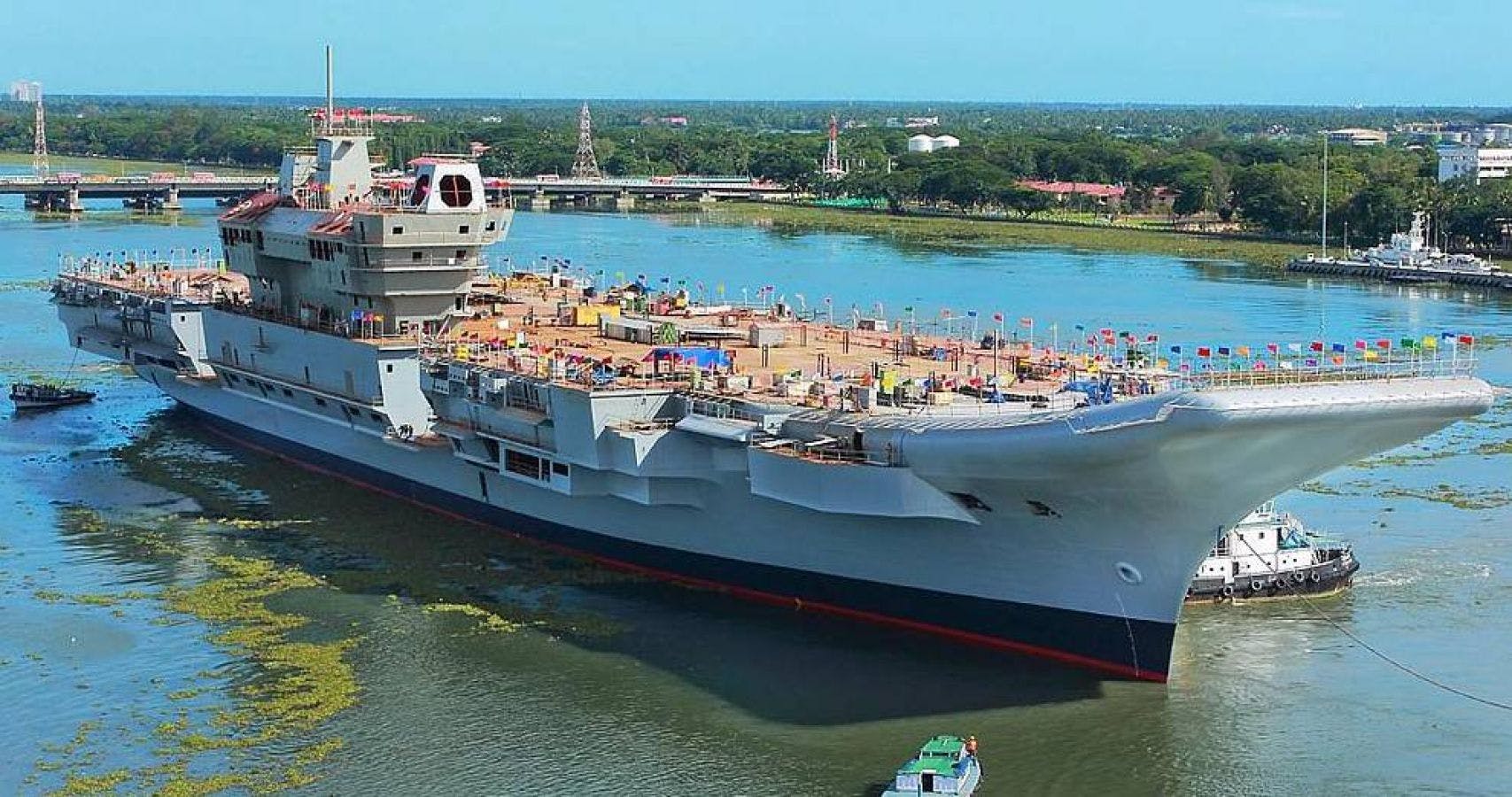
There are proposals to build the much larger IAC-2 of 65,000 tonnes, planned to enter service in the 2030s. Despite the considerable delays to India’s carrier programmes, more than any other country she provides a salutary lesson for current and prospective operators of aircraft carriers. India is the only nation to have experience of CATOBAR, STOVL and STOBAR operations. Prior to the 1989 retirement of the Bregeut Alizé ASW aircraft and the subsequent addition of a ski jump, the Majestic class carrier INS VIKRANT retained a catapult and arrestor gear and operated a mix of Conventional Take Off and Landing (CTOL) Alizé and STOVL Sea Harrier aircraft. Having had familiarity with all three configurations, the 65,000 ton conventionally powered IAC-2 INS VISHAAL will be equipped for CATOBAR operations probably employing the Electromagnetic Aircraft Launch System (EMALS). This suggests that India has experienced the limitations of STOVL and STOBAR operation and concluded that the use of catapults and arrestor gear is the most effective method of launching and recovering aircraft at sea.
In yet another interesting development pioneered by the Indian Navy, a Request For Information (RFI) was issued for the supply of fifty-seven fighter aircraft. This is in itself nothing unusual, however operating only STOBAR equipped carriers the field would appear limited to the MiG-29K and HAL Tejas. Having indicated that they were generally dissatisfied with the performance of the MiG and a preference for a twin engined fighter the Indian Navy has focused its attention on purchasing either the Boeing F/A-18 Super Hornet or the Dassault Rafale M. Both companies have claimed that their products are capable of operation from the VIKRANT and as well as the VISHAAL. This will be a unique situation, with the Indian Navy demonstrating the adaptability of one aircraft type using two systems of launching aircraft. Could this mean that there might be in the future an ‘adaptable carrier’ equipped with both a ski ramp and catapults? Time will tell, at the moment there exist drawings and models of such a ship, the Russian Shturm class, however the prospect of it being built is almost non-existent.
ITALY
Entering service in 1985 the Marina Militare’s (MM – Italian Navy’s) 14,150 ton ITS GIUSEPPE GARIBALDI was fitted with a ski ramp for use by Boeing AV-8B+ Harrier IIs. In Operation Unified Protector, the 2011 operation against the Libyan regime of Muammar Gaddafi, eight AV-8Bs flying from the GIUSEPPE GARIBALDI dropped a total of 160 guided bombs, and flew a total of 1,221 hours. The same factors which proved so decisive in the Falklands conflict were reinforced by Italian operations over Libya. As a small force operating close to the conflict zone the Italian GRUPpo AERomobili (GRUPAER – Embarked Aircraft Group) flew 33 per cent of Italy’s total sorties, and 53 per cent of the attack missions with little tanker support.
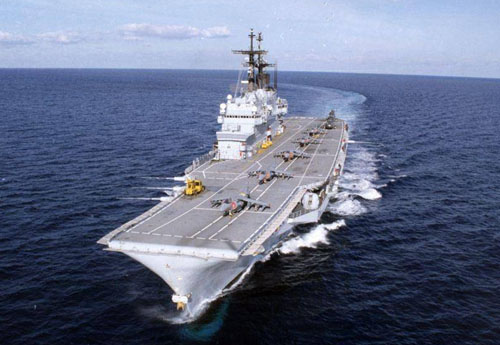
This disproportionate contribution again highlighted the impact that even a small aircraft carrier embarking a few Harriers can make. It also emphasised the foolhardiness of the 2010 decision by the Conservative Government of David Cameron to scrap the Joint Force Harrier (JFH) BAE HARRIER GR.9/9As along with HMS ARK ROYAL.
This MM also operates the 30,000 tonne ITS CAVOUR which was designed from the outset to operate F-35B fighters. The CAVOUR entered a dry dock at the Taranto navy yard to receive upgrades that will allow it to operate F-35B jets including the application of a heat resistant coating applied to its flight deck. It is equipped with the Selex European Multifunction Phased Array Radar (EMPAR) 3D radar and for self-defence four 8-cell A-43 Sylver launchers carrying the MBDA Aster 15 Surface-to-Air Missile (SAM) and two Oto Melara 76mm Super Rapido guns. Possessing a well deck, this vessel is truly multi-role, being able to operate as either a light carrier or an LHD. Fifteen F-35Bs have been purchased by the Italian government for the MM with a further fifteen purchased for the Aeronautica Militare (AM – Italian Air Force).
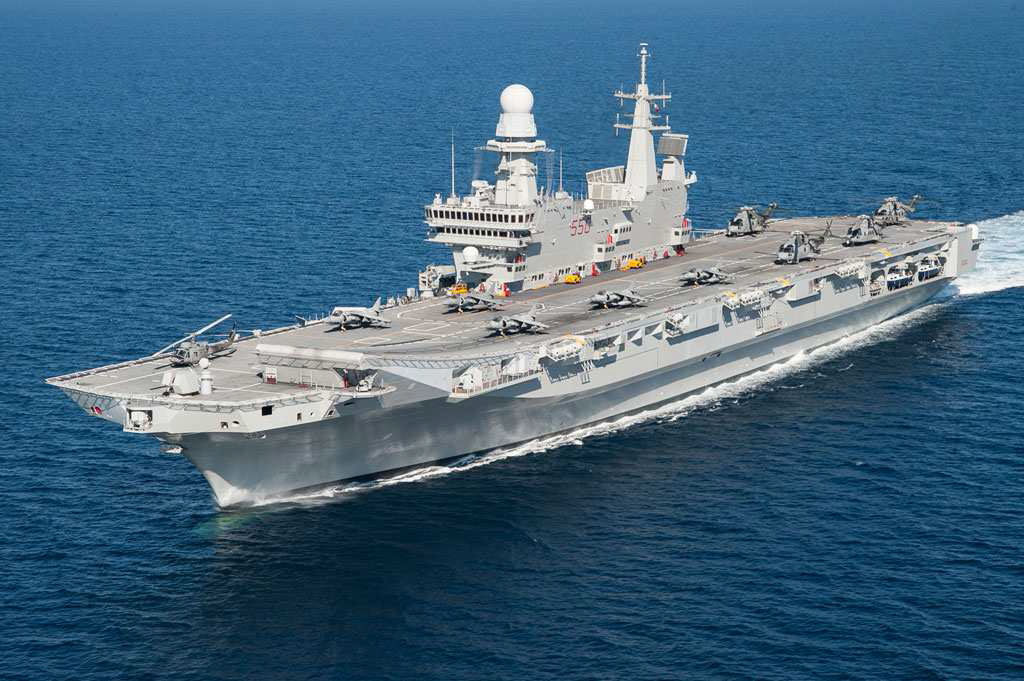
The ITS TRIESTE at 33,000 tons will be the largest ship in the MM when commissioned into service in 2022 replacing the GIUSEPPE GARIBALDI. The LHD will carry F-35B aircraft alongside Leonardo EH-101 and NHIndustries NH90 helicopters. Along with the QEC, the TRIESTE is unique among aircraft carriers/LHDs in that it has twin islands.
JAPAN
The 27,000 ton Izumo class are officially designated as multi-purpose destroyers in service with the Japanese Maritime Self-Defense Force (JMSDF) because of a limitation imposed in Article 9 of the post WWII Japanese Constitution which prohibits the acquisition of offensive weapons. The two ships of the class, JS IZUMO and JS KAGA were commissioned into service in March 2015 and March 2017 respectively. Facing increasing Chinese aggression in the East China Sea and heightened tension over the Senkaku Islands, with both China and Taiwan challenging Japan’s sovereignty over the islands, consideration was given in December 2017 to modify the Izumo class vessels into aircraft carriers.
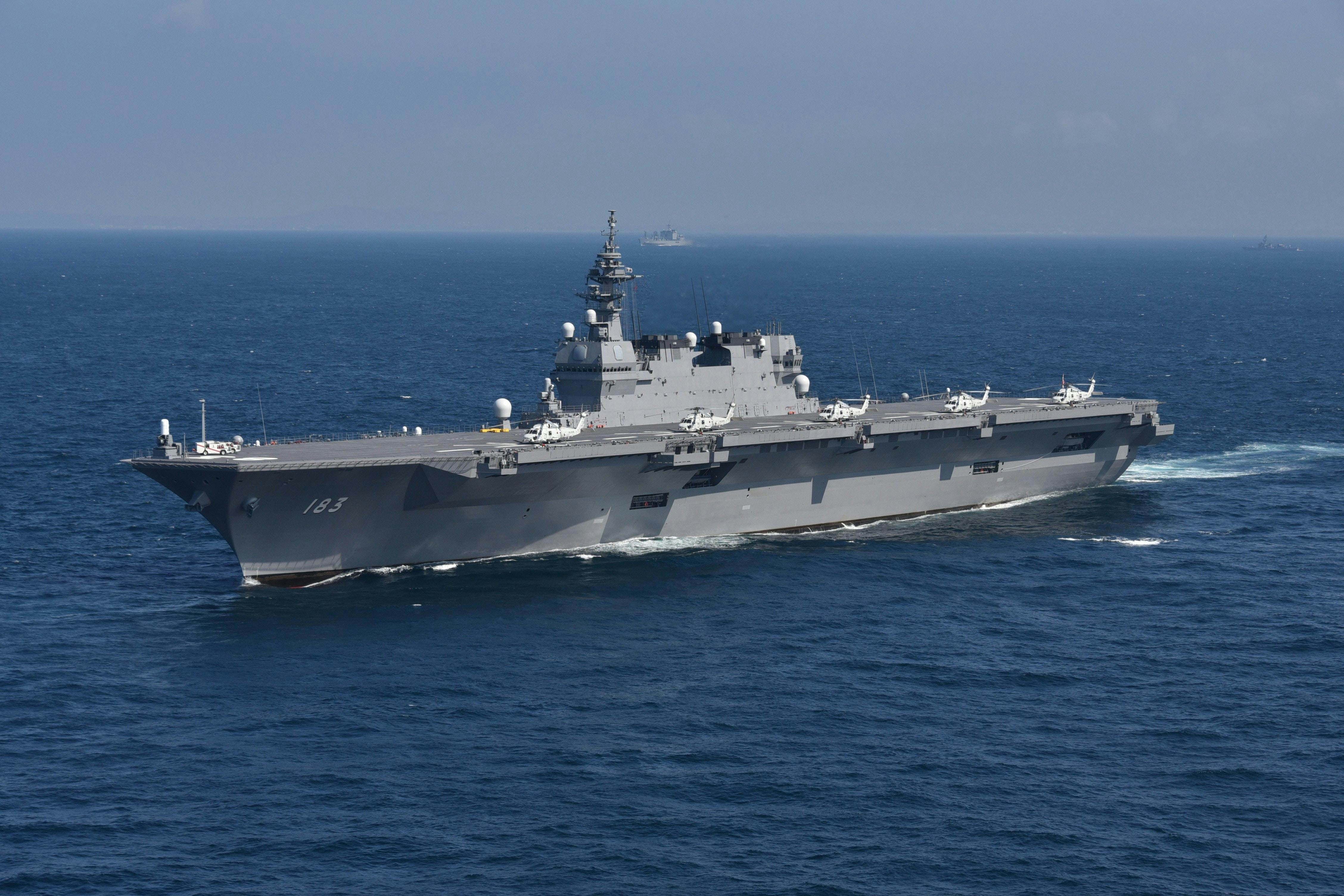
On 18 December 2018, the Japanese Cabinet gave approval to adapt them to permit fixed-wing operations. The modifications will include reinforcing their flight decks to support the additional weight of F-35B, as well providing a coating to the flight deck to dissipate the heat generated from jet efflux during vertical landing. Once modified, to all intents and purpose these ships will be aircraft carriers, but the Japanese Constitution dictates that they are designated ‘multi-purpose operation destroyers’.
In addition to the approval given to modify the ships the Japanese Cabinet also endorsed the purchase of forty-two F-35Bs, more than sufficient to equip both carriers whose normal load would be twelve aircraft in addition to helicopters. Japan will be the only nation alongside the United States to operate Boeing V-22 Osprey tilt-rotor aircraft from aircraft carriers. In July 2015 Japan ordered five of the V-22B Block C variant with an eventual requirement for seventeen aircraft. Japan will operate the same variant which is in service with the USMC. Of particular interest will be the possibility of the JMSDF operating their Ospreys with the probe-and-drogue V-22 Aerial Refuelling System (VARS) designed to provide greater range for the F-35B.
SOUTH KOREA
The 14,200 ton ROKS DOKDO amphibious assault ship was commissioned into service with the Republic of Korea Navy (ROKN) on 3 July 2007. Her sister ship, the ROKS MIRADO, will enter service in 2020. She is of a slightly different design to the first in class and is fitted with an Israeli ELM-2248 (MF-STAR) multifunction surveillance radar in place of the Thales SMART-L surveillance radar, Phalanx instead of Goalkeeper CIWS (Close-In Weapons Systems) and possesses a larger flight deck and hanger space which permits the operation of two V-22 Ospreys instead of one on the earlier vessel.
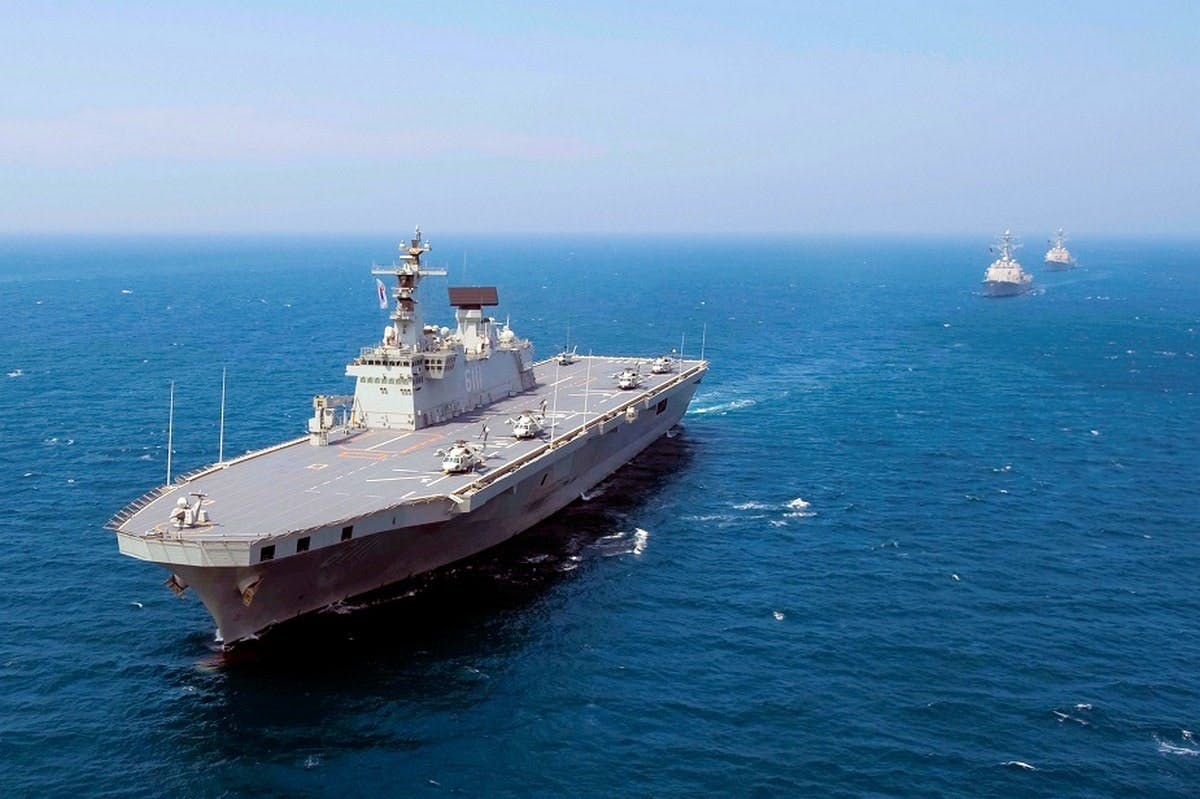
In December 2017 The Korean Herald newspaper quoting the Yonhap News Agency reported that the ROKN was considering a purchase of F-35Bs for operation from the MIRADO.[3] Writing in The Diplomat online journal in January 2018 the commentator Richard Farley noted that because of their size the Dokdos would require considerable modification to permit the operation of F-35s. In December 2019 reports emerged that Hyundai Heavy Industries has been contracted to design a much larger ship designated the LPH-II. Due in service in the early 2030s, it is expected to carry 16 STOVL aircraft, 3,000 marines and 20 armoured vehicles and be fitted with ski ramp. Bizarrely (to Western eyes) South Korea’s ambitions to build a light carrier are in answer to a perceived threat posed by Japan, not China.
TURKEY
In December 2013 the Türk Donanmasi (Turkish Navy) ordered a ship based on a modified BPE design specifically for the intention to operate the F-35B. The TCG ANADOLOU will enter service in late 2020.
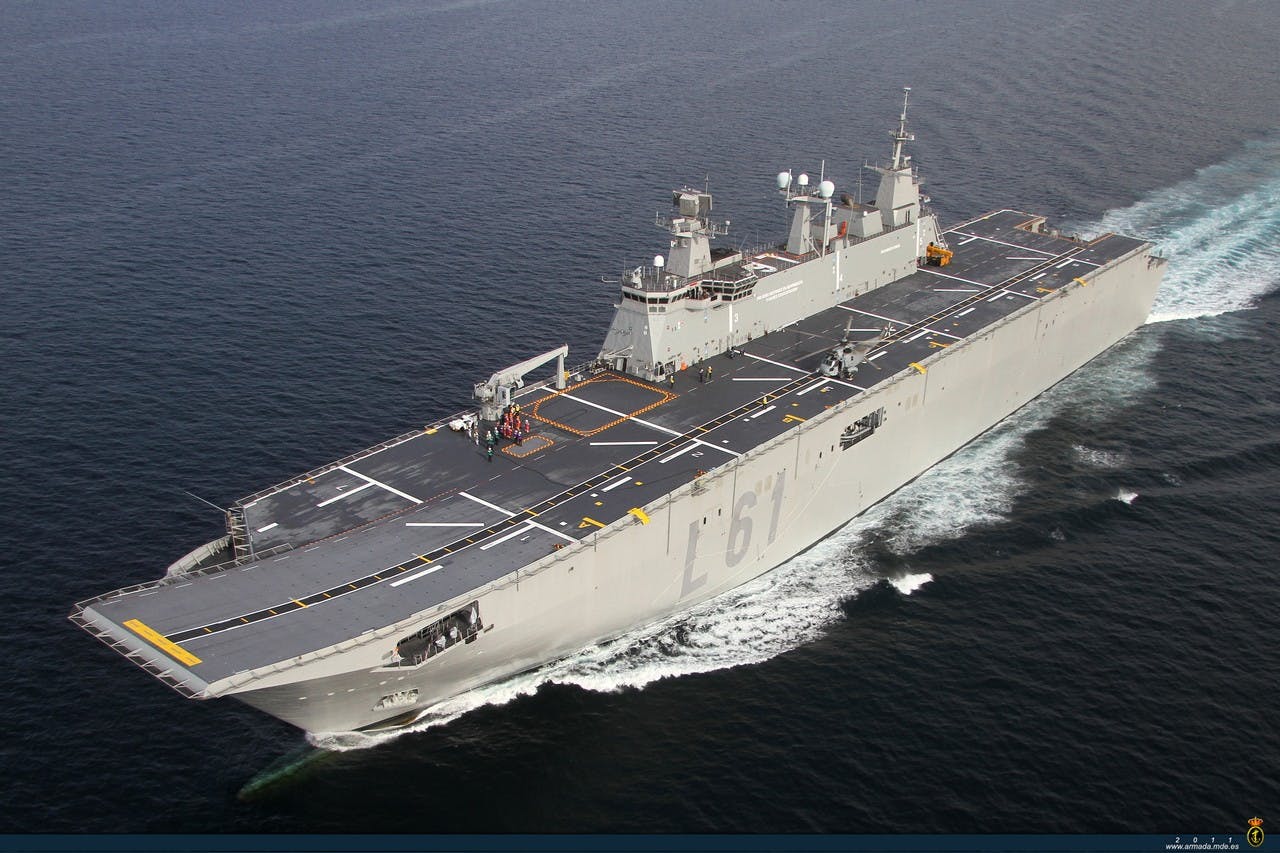
She is built with a higher standard of equipment than either her Spanish or Australian counterparts. The equipment includes the sophisticated SMART-S Mk.2 S-band 3D radar, a Leonardo SPN-720 Precision Approach Radar, a RIM-116 Rolling Airframe Missile (RAM) launcher, two Aselsan 25 mm STOP Remote Controlled Stabilized Naval Gun Systems and two Phalanx CIWS. Turkey’s ambitions to operate F-35Bs from the carrier came to a grinding halt in 2019 when the US removed Turkey from the F-35 programme, having been a Tier 3 partner, after the country took delivery of a Russian S-400 air defence system.[4]
UNITED KINGDOM
I wrote extensively on the future of UK carrier operations in my UK Defence Journal article Wartime Operations – Employing the Queen Elizabeth Class aircraft carriers and will add little further.

The programme to achieve Initial Operating Capability is on track and HMS QUEEN ELIZABETH will undertake her first deployment in 2021.
UNITED STATES
The latest US Navy carrier, the USS GERALD R. FORD was christened on 9 November 2013 but was not delivered to the navy until October 2019. Costing an eye-watering USD$13B the FORD is 1,092 ft long and weighs 100,000 tons. She is equipped with a number of new systems which have caused considerable problems. In 2014 a Director, Operational Test and Evaluation (DOT&E) report cited problems with the EMALS, Advanced Arresting Gear (AAG), AN/SPY-3 and AN/SPY-4 active electronically scanned array multi-function radar, software and the ship’s Advanced Weapons Elevators. These issues prevented delivery of the carrier initially scheduled for 2015.
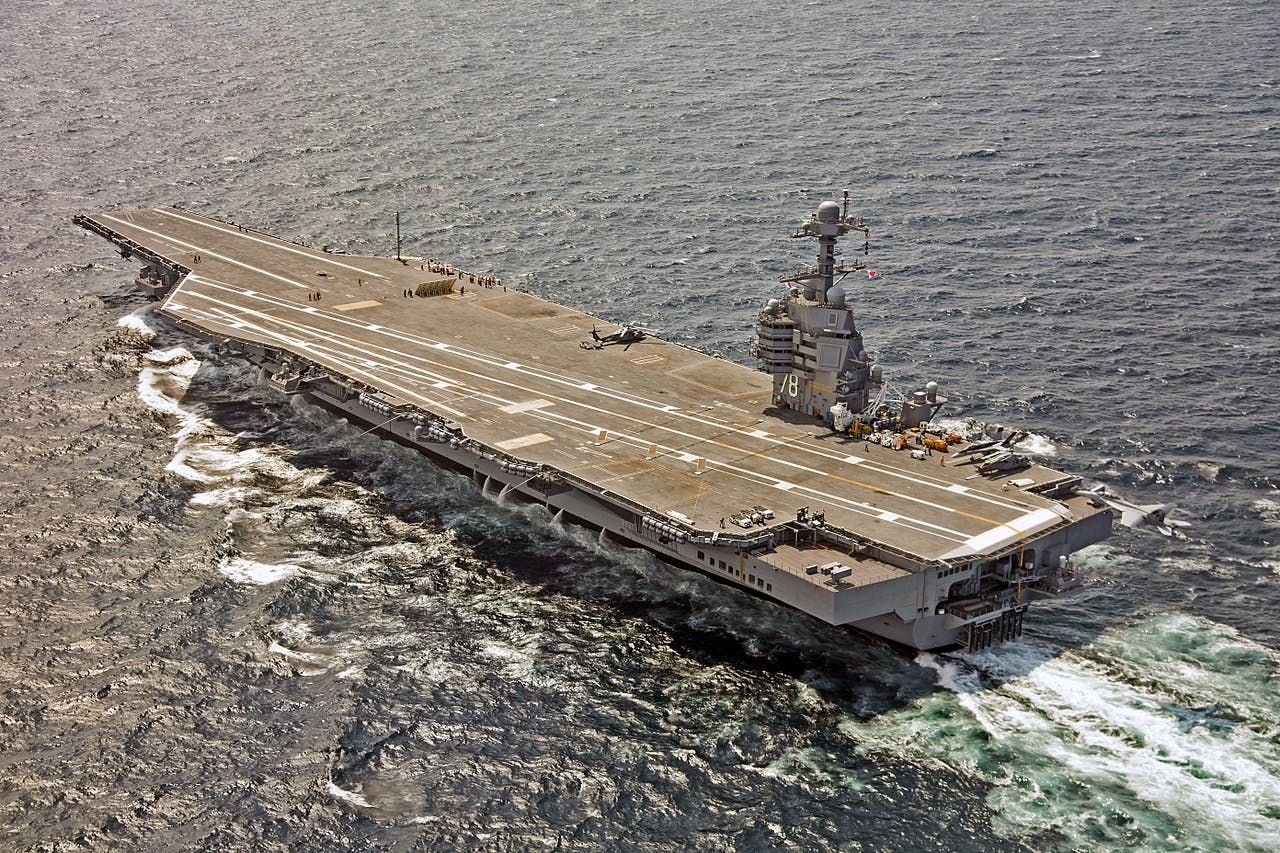
The most recent issue has been with the ship’s sewage system which requires an ‘acid flush’ on a regular basis at an unbelievable USD$400K per flush. On 20 March 2020 the FORD completed its Flight Deck Certification (FDC) and Carrier Air Traffic Control Center (CATCC) certification following two days of intense flight deck operations to prove the capabilities of the ship and crew. Her first operational deployment is scheduled for 2022. The second ship in the class USS JOHN F, KENNEDY was christened on December 7, 2019. She will be followed by ENTERPRISE and DORIS MILLER.
In part due to the inordinately high cost of the Ford class, but also in acknowledgement of the increasing vulnerability of carriers to Anti-Ship Missiles (AShMs) the USN is now actively considering its investment in future carriers.
On March 5 2020 the online journal Breaking Defense reported that the USN has formed The Future Carrier 2030 Task Force which is due to report back by the middle of the year.[6] The USN and USMC consider a response to the growing problems of cost and vulnerability, as well as the challenges posed by China, could be the use of amphibious assault ships as ‘Lightning carriers’.

The concept has been proven with the successful deployment of F-35Bs in March 2018 on the USS WASP. On 27 September 2018 F-35Bs flying from the WASP’s sister ship USS ESSEX conducted a strike on a fixed target in Afghanistan. By February 2019 F-35Bs flying from the ESSEX spent 1,200 combat hours over Iraq and Syria conducting strikes against IS, a considerable achievement considering there were only six jets aboard.
The USS AMERICA is the first of a class of five amphibious assault ships and at 44,971 tons is 5,000 tons heavier than the Wasp class. The ship is notable in that it no longer incorporates a well deck for amphibious vehicles. This permits the carriage of more aircraft. Operating as small carriers with a complement of 20 F-35Bs and 2 Sikorsky UH-60S helicopters the America class could successfully be deployed into conflict zones where the USN’s super carriers were either deemed to be unnecessarily large for the task or were unavailable.
CONCLUSION
The worth of aircraft carriers is now undisputed and any notion that their day is now over is contradicted by the worldwide construction activity to build these ships. The navies of the world will thus be divided into those which have the full range of capabilities which are offered by the operation of a carrier and those without. In any future conflict it is the latter which will be found severely wanting. The aircraft carrier alone can provide power projection unrivalled by any other ship and as the centrepiece of a Carrier Strike Group will provide a navy with capabilities which others without carriers will find difficult, if impossible to match.
Nations across the world have been affected by the deadly Coronavirus. In attempting to address the serious health and economic issues arising out of the crisis Western governments have spent billions. This will have an impact for decades to come. In such circumstances governments will look to cut expenditure wherever possible and inevitably will look to spending on defence as one possible area for cuts. This is understandable; any government must look to the health and wellbeing of its people as its first priority. Nevertheless a government must also protect its people from outside aggression which can be equally as devastating as any virus. Authoritarian governments demonstrate no such responsibility to their people and in a time of global crisis can use the circumstances to their own advantage. Western governments must remain vigilant and consider very seriously that a cut in defence spending could lead to a potential further crisis.
From this author to UK Defence Journal readers: stay home; stay safe; maintain a safe distance from others; and be deeply grateful to our fantastic health professionals.
References
[1] https://www.aspistrategist.org.au/should-australia-follow-japan-and-take-the-f-35-to-sea/
[2] For a comprehensive overview of the Chinese People’s Liberation Army Navy’s (PLAN’s) aircraft carriers and future developments see my earlier UKDJ article ‘A Look at China’s new Type 002 Shandong Aircraft Carrier’ at: https://ukdefencejournal.org.uk/a-look-at-chinas-new-type-002-shandong-aircraft-carrier/
[3] http://www.koreaherald.com/view.php?ud=20171225000070
[4] https://ukdefencejournal.org.uk/turkey-to-operate-carrier-without-jets-in-2020/
[5] https://ukdefencejournal.org.uk/wartime-operations-employing-the-queen-elizabeth-class-aircraft-carriers/
[6] https://breakingdefense.com/2020/03/beyond-uss-ford-navy-will-study-next-generation-aircraft-carriers-exclusive/


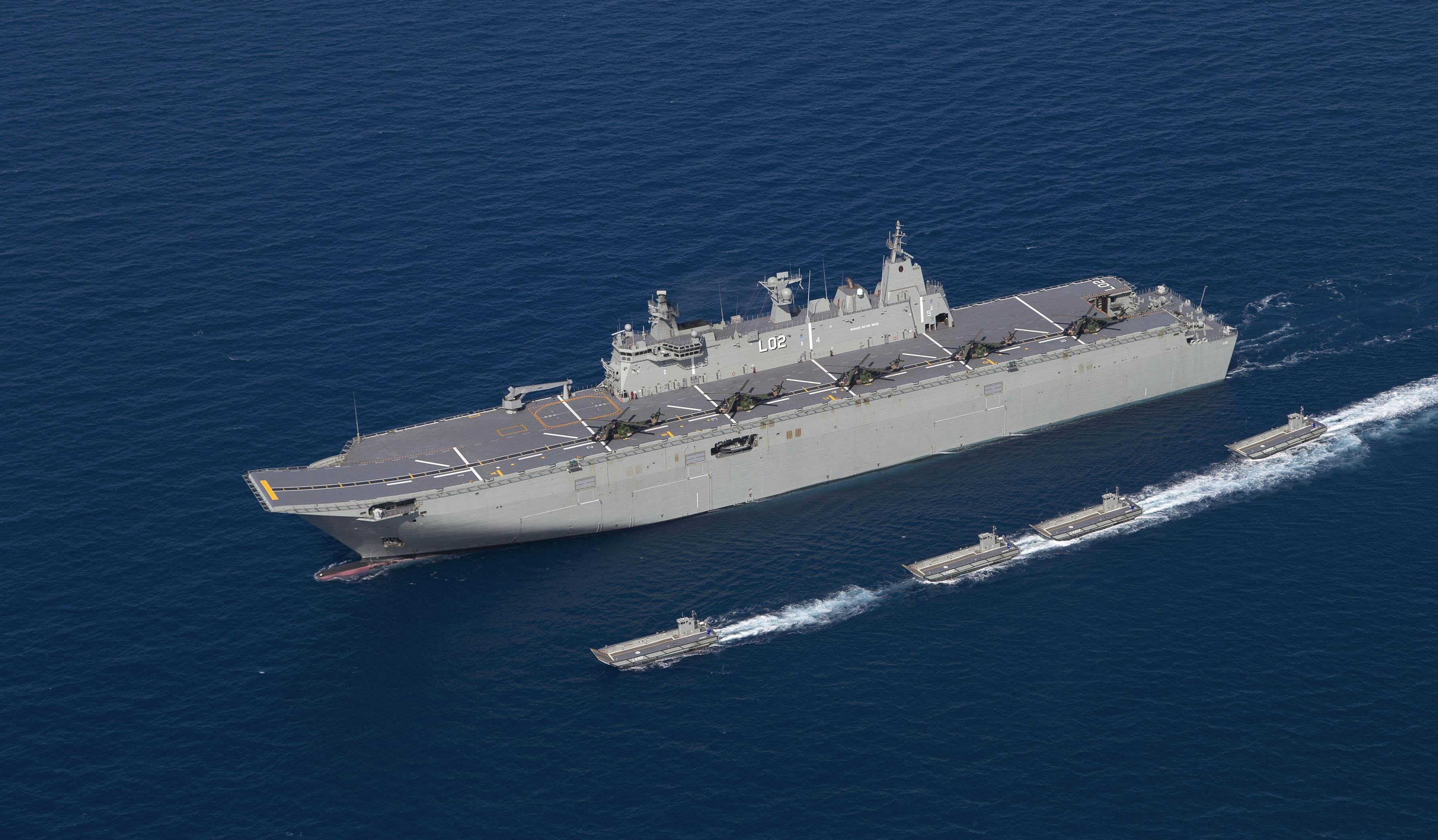
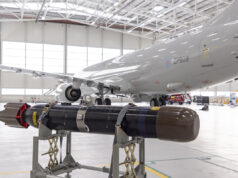
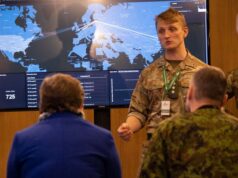









Valid points.
It is always the western democracies expected to disarm first.
Only by some eejits. Remember when UN planes weren’t supposed to follow Soviet and Chinese Migs over the Yalu in Korea ? Thye did, all the time.
The hazard of being accountable to your population, unfortunately. Too many people think war is just some expensive hobby, and that if we just scrap the armed forces and stop exporting weapons then the world will be all sunshine and rainbows.
Max Hastings forsooth! These vessels are far more than platforms for aircraft, they can perform a phalanx of tasks, and all to the benefit of their operating navies. long may they sail.
I see you didn’t mention Iran’s carrier? Which can be found on google maps 27°08’08.3″N 56°12’04.4″E in the docks of Bandar Abbas……..;)
Seriously though, although the nuclear powered hunter killer submarine rules the seas, the carrier brings a lot more flexibility. For starters it’s more overt rather than covert. Yes there may be a sub lurking off your coastline, but with nearly 1000ft of sovereign airfield operating outside your EEZ, you will take more notice. Secondly you can’t really use a sub for humanitarian relief in a disaster zone, you can with a carrier.
What a lot of people seem to forget is that a carrier will never operate on its own. It will be part of a task group, especially if it’s sailing in harms way. For our carriers it will have their own air group doing constant combat air patrols, watching the sea and airspace with Crowsnest equipped Merlin and other Merlins tasked with sub huinting. But then the task group will also include dedicated anti-air destroyers, dedicated anti-submarine frigates and probably a SSN in close proximity. It may even have Wedgetail and Poseidon support. There will be a lot of fences to cross before anybody or anything gets close to the carrier.
Why are China and Iran expending significant amounts of resources developing anti-ship ballistic missiles (ASBM). It’s because of the threat that carriers bring. The ASBM may be viewed as the answer to the carrier threat, but first you have to find it and then continuously track it. A long range surveillance aircraft will not get with range, if the ship is operating with an exclusion zone. A ship or boat again not a chance. A submarine, possibly if it can get past the SSN, ASW frigates and Merlins. The best chance would be satellite surveillance, but again you need an idea in which part of the ocean to watch. But then is your satellite geostationary or geosynchronous? What if we decided to use a laser to dazzle the cameras of the satellite, good luck with tracking after that. No, the carrier still has a massive part to play as a force multiplier and offensive weapon system. Granted, Countries are making new weapons designed to counter the carrier, but its not like we are standing still and doing nothing to counter the new threat!
The threat from satellite surveillance is likely to change with future LEO satellite networks, combined with low cost and high frequency launches, primarily as a threat from Tier 1 adversaries. It may result in a continuous, active network, of many thousands of satellites, where a CSG doesn’t have to be found because it is almost continuously tracked. The USAF already have contracts for use of the SpaceX Starlink network, I doubt they are the only military looking to exploit such networks.
Can we “shoot out” the satellite sensors? Perhaps, but its likely satellites and the network will be designed to counter and adapt to this in order to provide targeting for ballistic missiles, so we shouldn’t assume an easy counter. This threat is probably the main driver behind the US review regarding their large carriers and amphib ships. Its probably why there is also a focus on NATO ship-based BMD, as traditional layered defence isn’t going to work against ASBM.
The future threat from a combination of LEO satellite networks and ASBMs doesn’t negate carriers, but it does make them much more vulnerable than has been the case over the last 3/4 of a century. It should also be recognized that large amphibious ships, operating relatively close inshore, at relatively low speeds are even more vulnerable to ASBM; something to consider wrt to the UK’s Albion and Bay-class vessels and any future replacements.
I agree. I know the MoD have approached the Surrey Satellite Centre on a request for information regarding their cubesats. Especially with regards to the cubesats operating as a network. Due to their size, they wont be able to house a powerful radar, necessary to reach the Oceans surface. They can carry electro-optics covering the whole light spectrum. They can also be used as communication nodes or perhaps more importantly as Global Position System replacements. Due their low weight and size, they can be launched from smaller rockets either vertically or using the horizontal technique.
There are now sufficiently productionised lasers that have the range and power to dazzle the optics of satellites. Whether they have the power to destroy the sensor is a question none of the manufacturers are reporting on.
The USMC are quite rightly worried about assaulting a defended beach, with their amphibious ships sitting on or near the horizon. They got rid of their major means of suppressing the beach area, i.e. the battleship. It was manpower intensive, but could lay down a serious amount of hurt and just as importantly soak up damage. The Zumwalt that was supposed to take over the role of naval gunfire support (NGFS) went massively over budget, so they cancelled its role. The NGFS role is now going to be done by the Burkes with their standard 5″ guns. They will also be using TLAM, but these are massively expensive compared to the 5″ shell. These are better suited to point targets as they don’t have massive collateral damage compared to a broadside of 16″ shells.
The USMC have prioritised the development of a family of UAVs to fulfil their Marine Air/Ground Task Force, Unmanned Aerial System, Expeditionary (MUX) program. This program covers all their requirements from small squad reconnaissance to a large radar surveillance unmanned aircraft. They also have a requirement for a dedicated close air support. However they are still investigating on how to protect their troop carriers. One of the methods is to spread the load by using lots of smaller ships. They are also looking at a magazine ship, which is networked with a Destroyer/Cruiser. This ship would carry additional anti-air and surface to surface missiles. But it negates the fact that troop ships have traditionally been under-armed for offence let alone self defence. A pair of Phalanx CIWS is the norm, but is that really good enough. Why do you need a Frigate/Destroyer for NGFS? Wouldn’t it be better to fit the gun system to the troop carrier, as its already in the right position? For air defence should these ships at least be fitted with a decent anti-air missile system. The Sea Ceptor is relatively cheap, has a very high rate of fire and can literally be bolted on. There will always be a need of landing troops on a beach, so shouldn’t the ship getting them there have the means to properly support them and defend itself?
A few further thoughts on your points.
Dazzling the sensor requires it to be exposed. A simple counter might be to trade off continuous surveillance by only periodically exposing the sensor, on a duty cycle consistent with still providing adequate detection capability. A countering laser would then have to hit at the same time as the sensor is exposed, since the laser cannot be maintained indefinitely. Further gated by only exposing the sensor in the absence of laser detection by the satellite to improve the odds.
I don’t see NGFS being seriously pursued in future. If that were so then the USN would spec a 125mm on their otherwise well equipped new frigate, not a 57mm. No point in putting a Burke at risk if there is intent to carry out NGFS. This pull back from NGFS seems to be driven by several considerations, a) no one seriously considers doing opposed beach landings b) the same ballistic threat we are talking about for carriers and amphibs also applies to any ship operating in a constrained area that makes it easier to target and c) not enough weight of fire from a 125mm. If still intent on land bombardment then ship launched HIMARS seems more likely as already trialed.
MUX as we knew it seems to be dead, per USNI article –
https://news.usni.org/2020/03/10/marines-ditch-mux-ship-based-drone-to-pursue-large-land-based-uas-smaller-shipboard-vehicle
I had hoped an affordable option for increased capability over Crowsnest might have come from that program in due course but it seems the affordable bit wasn’t there for the US either. Perhaps a wing based hybrid platform similar to Rolls Royce EVTOL might be a more practical option, e.g. https://www.rolls-royce.com/media/our-stories/discover/2018/blue-sky-thinking-rr-unveils-evtol-concept-at-farnborough-airshow.aspx
A few further thoughts on your points.
Dazzling the sensor requires it to be exposed. A simple counter might be to trade off continuous surveillance by only periodically exposing the sensor, on a duty cycle consistent with still providing adequate detection capability. A countering laser would then have to hit at the same time as the sensor is exposed, since the laser cannot be maintained indefinitely. Further gated by only exposing the sensor in the absence of laser detection by the satellite to improve the odds.
I don’t see NGFS being seriously pursued in future. If that were so then the USN would spec a 125mm on their otherwise well equipped new frigate, not a 57mm. No point in putting a Burke at risk if there is intent to carry out NGFS. This pull back from NGFS seems to be driven by several considerations, a) no one seriously considers doing opposed beach landings b) the same ballistic threat we are talking about for carriers and amphibs also applies to any ship operating in a constrained area that makes it easier to target and c) not enough weight of fire from a 125mm. If still intent on land bombardment then ship launched HIMARS seems more likely as already trialed.
MUX as we knew it seems to be dead, per USNI article. I had hoped an affordable option for increased capability over Crowsnest might have come from that program in due course but it seems the affordable bit wasn’t there for the US either. Perhaps a wing based hybrid platform similar to Rolls Royce EVTOL might be a more practical option.
Sorry Davey, tried to include links but my post disappeared into moderation which usually means permanently. Do a search on “Marines Ditch MUX” for USNI article and “The Rolls-Royce EVTOL project” for the RR electric hybrid tilt-rotor concept.
Yeah I saw the USNI article, it did say parts of the MUX was dead but not the whole program. I think the USMC were looking to have a fully multi-role UAV, but this appeared impossible to achieve when trying to meet everyone’s requirements. I am still rather hopeful that they will further develop the Bell V247 Vigilant, as it meets the specs of at least three requirements. The Dep Com did state there is a requirement for the amphib’ carriers to have an embedded AEW aircraft, so they are not always reliant on the Hawkeyes. He did allude to how difficult it is to develop an aircraft as complex as a AEW UAV and to keep it within certain weight margins. I was really hoping that the USMC would go down that path, as it would have been an excellent replacement for the Crowsnest equipped Merlins.
I believe the USMC have done a trial a couple of years ago with HIMARS strapped to the deck of one of their ships and it proved successful. Will it replace NGFS, I’m not so sure due to the cost. But I stand corrected if that’s the path they take. The Commandant of the USMC has stated that they are giving up their heavy armour to concentrate on ship based duties, raiding and neutralising threats to the Navy. Sounds very much like what we’re doing with out Marines. Neutralising threats to the Navy is an interesting statement though, as it could mean many things. Personally, I think they are looking at the fortified islands that China has built in the South China Sea (SCS). I know a couple of tanker friends in the US Army and they think dropping the armour is a stupid decision (bat sh*t crazy – their words). So I don’t believe they will ever drop opposed landings, but rather than kicking in the door; like us, they’ll try the open window round the back first.
Its an interesting thought on how to prevent a reconnaissance satellite from doing its job and what measures you can take to defend your own. Once the satellite is launched its pretty much up their on its own. Gone are the days when satellites could be mid-life upgraded, by launching a shuttle and getting the crew to do the modification. An iris mechanism would be best suited to defend the optics. But again it depends on how powerful the laser is. Could it be powerful enough to melt the lens or weld the iris shut? There are other measures you can do with satellite, such as changing its predicted path, which unfortunately uses up fuel which is not plentiful. I am pretty certain if we came to blows with a peer Nation, satellites will be the priority day one targets of the future.
A 50000 tonne ship is still pretty big. So a larger number of smaller ones would give greater flexibility, but would have probably larger numbers of (expensive) crews.
Perhaps the requirement is for simpler platforms to store ships with maintenance (and control and tasking) on larger carriers.
The fact is that in limited local wars the Carrier is an absolute necessary asset, in a world war an asset for about 5 minutes and then kaboom,
Whats likely , local conflicts so the Carrier is a must
These aren’t going to be launching strikes into China or Russia any time soon, not with current A2/AD, but 50 years is a long time.
Why no mention of France, the only other nation besides the USA, with a nuclear powered carrier and Thailand which also possesses a LHD type carrier 9f Spanish design?
Brazil is disposing of its old French carrier (Clemenceau) but 8s discussing acquiring an LHD type creplacement.
I think the emphasis of the article is on nations in the process of advanced planning/building new carriers hence the omission of France. As for Brazil one could argue that ex HMS Ocean is at least an interim replacement offering limited air power
Obviously the smaller ships can’t maintain the intensity of operations like the Nimitz carriers but they still very useful for limited operations and are more than just carriers as Maurice10 has said.
As for ‘. It also emphasised the foolhardiness of the 2010 decision by the Conservative Government of David Cameron to scrap the Joint Force Harrier (JFH) BAE HARRIER GR.9/9As along with HMS ARK ROYAL’, too bloody right.
I note we’re still getting ‘Doris Miller’ when it should be ‘Dorris Miller’ – bit like the BBC using graphics credited to ‘John Hopkins’ in Baltimore when the establishment is actually called ‘Johns Hopkins’.
Look Aircraft Carriers are the means of power projection for any power. The Russians like to talk about hyper-sonic missiles and attack submarines but if they could produce several large carriers affordably, they would wouldn’t they. Now the best nuclear powered design is the Ford Class and the best conventional carrier is the QE Class, we should be very proud of that. France, India and even the USA are markets for our brilliant ‘Harrier Carrier’ design.
Off-topic, but good news none the less!
“The UK Royal Navy (RN) Type 23 frigate HMS Portland has become the first ship of its class to be fitted with the Sonar 2150 hull-mounted medium-frequency sonar.”
First Sonar 2150 sonar fit completed on Type 23 frigate.
https://www.janes.com/article/95393/first-sonar-2150-sonar-fit-completed-on-type-23-frigate
Did you also see the following:
https://www.janes.com/article/95357/rn-to-trial-mad-equipment-on-merlin-hm2
Hi DaveyB, missed that one, thanks for sharing. It appears we are moving in the right direction, long may it continue!
Interesting that Japan and South Korea are at each other’s throats.
Remember the support China gave to North Viet Nam up to 1975 ? 4 years later they were fighting a border war.
The Chinese got their arses handed to them by the Vietnamese ion the border war. It also led to a major reshuffle and rethink of how the PLA functions and operates. The following border war ended in a draw, so I guess they actually did put their previous experience into practice.
The Vietnamese have just accused the Chinese coastguard of deliberately ramming and sinking one of their fishing vessels off the Paracel Islands.
China flexing its muscles again.
The Chinese did not seem use their best PLA units for the Invasion of Vietnam, it was more a punitive exercise to send a signal to the Vietnamese Government. The Vietnamese fought back mostly using militia units, some fighting behind the lines. Vietnam held their best units back in case the Chinese were intent on a bigger conflict. It proved a costly conflict to the Chinese PLA for what it achieved, as well as a learning exercise to the PLA military planners.
In terms of Political alignment they are reasonably similar but Historically they are Enemies.
Japan has a history of subjecting Korea going back hundreds of years which it barely acknowlages, let alone apologises for, so it’s hardly rocket science. Let’s hope it improves sooner rather than later.
Didnt the yanks sink uss America?
I think our QE carriers are too vulnerable with only Phalanx as a last ditch AA/ASM defence. In WW2 we had the largest fleet in the world but still lost a carrier caught alone with all aircraft stowed & only 2 small destroyers escorting to German battlecruisers. With the tiny RN escort fleet(& most allied fleets very small) we really should at least come up to the USN standard. They have the largest fleet in the world yet protect their carriers with ESSM SAM, RAM CIWS/SAM & Phalanx. 3-tier defences. We should be fitting the Sea Ceptor SAM at least.